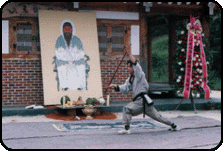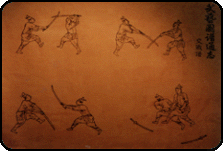Gyongdang
..................................![]() Overview
Overview
![]() PKG Tours
PKG Tours
![]() Video Clips
Video Clips
..................................
![]()
Jeju Championship

¢Ñ What is? | ¢Ñ Origin | ¢Ñ Mu-Ye-Do-Bo-Tong-Ji | ¢Ñ 24 Military Arts
 Some of the East's
martial art's originated during the Goguryo Dynasty. The purpose
of martial art's training was to develop a military or disciplined
mind and spirit. It was also used to promote devotion to the welfare
of mankind and make the world a better place.
Some of the East's
martial art's originated during the Goguryo Dynasty. The purpose
of martial art's training was to develop a military or disciplined
mind and spirit. It was also used to promote devotion to the welfare
of mankind and make the world a better place.
The Gyongdang has inherited
this spirit of devotion to the welfare of mankind. This spirit has
been expressed since the birth of our nation. During the Goguryo
period martial arts emphasized independence, self sufficiency and
self-improvement.
Gyongdang's purpose is to cultivate our youths
ability to contribute to the reunification of our divided country,
to build a healthy society and to foster a sound mind and healthy
body.
The Gyongdang consists
of 24 military arts (Mu-Ye-Yi-Sip-Sa-Ban)
based upon on developing national
spirit, culture and history. Through this training we hope to enhance
the physical ability and mental capabilities of our youth. The 24 military arts practiced
in Gyongdang originated around the time of the Japanese invasion
of Korea in 1592.
Korea had led a peaceful life for 200 years
prior to this foreign invasion. Korea experienced a disastrous defeat
from the highly trained Japanese troops. During the course of the
war, during the Yi Dynasty, Korean martial arts began to develop
with the assistance of elite martial artists from China and Japan.
After the war between 1569 and 1790, two kings successively refined
the above mentioned military arts. Two famous scholars, Park Je-Ga
and Yi Deok-Mu, deeply versed in practical science, published a
military arts book containing 24 military
arts (the name of book is Mu Ye Do Bo Tong Ji)
These 24
military arts were a compulsory
requirement for regular Army troops until the annexation of Korea
by Japan in 1910. Even after the annexation, loyal troops fighting
for independence relied heavily on the 24
military arts.
PKG TOURS
 Gyongdang originated as an educational system during
the Goguryo period. Common youths in every village throughout the
country gathered together to study in military arts.
Gyongdang originated as an educational system during
the Goguryo period. Common youths in every village throughout the
country gathered together to study in military arts.
Thus they
would be prepared to engage in battles in time of war. The present
military art "Gyongdang" is intended to continue this
traditional training of the Goguryo period. The training is practical
and builds a sound mind and healthy body for daily life. The main
training center is located in Gwang-Ju and there are 15 branch schools
Seoul, Daegu and Busan. In the future we plan to establish schools
overseas.
 This book is an ancient Korean martial arts
manual, written by Yi Deok-Mu, Park Je-Ga and Pak Dong-Su in 1790,
under the order
This book is an ancient Korean martial arts
manual, written by Yi Deok-Mu, Park Je-Ga and Pak Dong-Su in 1790,
under the order
of King Jeongjo.
According to historic
documents, archery was the only official martial art that had been
practiced by the soldiers of Joseon (ancient name of Korea used
during the Yi Dynasty, 1392-1910). Considering the fact that yangban
(aristocratic class) literati dominated the political, economical,
and cultural life during this period, it is not surprising that
practice of martial arts was looked downed upon and generally discouraged.
After the Japanese invasion
(1592-1598), King Sunjo (1567-1608) acquired a Chinese martial arts
manual called Kihyo Shinsu written by Chuk Kye-kwang of the Ming
Dynasty. He took a personal interest in the arts and subsequently
invited the Ming military officers for a demonstration of their
fighting methods. The king ordered his military officer Han Kyo
to compile six fighting methods for further study. Han Kyo documented
the Gon-bang
(long stick), Deung-pae (shield art), Nang-sun (multiple tip bamboo spear), Jang-chang (long spear),
Dang-pa (triple
tip spear), and Ssang-su-do (long sword) which he published collectively under
the title Muye Jebo
(Martial Arts Illustrations).
Following this period, the
first Manchu invasion took place in 1627 (called Jeongmyo Horan)
and the second invasion in 1636 (called Byongja Horan). King Injo
(1623-1649) surrendered to the Manchus and his two sons, including
the Crown Prince Sohyon, had to accompany the Manchu army as hostages.
Compared to the war against the Japanese, the Manchu (the Ching Dynasty) invasion was of a short duration. Only a small part of the country became a battlefield, however the northwest province through which the Manchus passed was a killing field, resulting in intense hostility among Korean people toward the Ching Dynasty. King Hyojong (1649-1659) planned to launch a northern expedition and strengthened Korea¡¯s military defenses by intensifying training and repairing fortresses atop the mountains around the capital.
During the reign of
King Youngjo (1724-1776), the publication of Muye
Jebo was revised and renamed
Muye Sinbo
(Martial Arts New Illustrations) with twelve additional fighting
methods added: Juk-jang-chang (long bamboo spear), Gi-chang (flag spear), Ye-do (short sword), Wae-gum (Japanese sword),
Gyo-jeon (combat engagement), Wol-do (crescent sword), Hyop-do (spear sword), Ssang-gum (twin swords), Je-dok-gum
(admiral¡¯s sword), Bon-guk-gum (Shilla
Kingdom sword), Gwon-bop (fist fighting method), and Pyuo-gon (flail method).
It was King Jeongjo (1776-1800) who added six more fighting methods and completed the Muye Dobo Tongji (Comprehensive Illustrated Manual of Martial Arts). Those six methods are Gi-chang (spear fighting on horseback), Ma-sang-wol-do (crescent sword on horseback), Ma-sang-ssang-gum (twin swords on horseback), Ma-sang-pyon-gon (flail method on horseback), Gyok-gu (ball game on horseback), and Ma-sang-jae (horsemanship). He intended to strengthen the national military forces by training soldiers daily and systematically. It is interesting to note that they included not only Chinese fighting methods in the manual but also the Japanese sword methods which had been totally ignored at the beginning of the dynasty. It is obvious that they wanted to prepare for both enemies.
After enduring nearly 1,000 wars since the founding of the country, Koreans have learned the importance of Yubimuhwan: when one is prepared, there is no room to fear the unexpected.
4. 24 Military Arts (Mu-Ye-Yi-Sip-Sa-Ban)
 The 24 Military
Arts are composed of 1026 techniques and various weapons. Individually
each technique is simple and plain. But when combined the techniques
become intricate and diverse. Included among the 24 military arts
weapons are: a 1.35 meter sword weighing 2.5 kilograms, spears
ranging from
The 24 Military
Arts are composed of 1026 techniques and various weapons. Individually
each technique is simple and plain. But when combined the techniques
become intricate and diverse. Included among the 24 military arts
weapons are: a 1.35 meter sword weighing 2.5 kilograms, spears
ranging from
2-6 meters, are both solemn and impressive.
These military arts were developed and refined through scholastic
studies and tested in two wars with neighboring countries. i.e,
the Japanese invasion in 1592 and the Manchu invasion in 1636. The
24 military arts are practical and efficient having been developed,
and refined through utilization in actual combat.
Mu-Ye-Yi-Sip-Sa-Ban, literally translated as 24 Technique Martial Art,
is made up of the 24 arts of the
Mu-Ye-Do-Bo-Tong-Ji.
In 1789, King Jeongjo, ruler of the Yi dynasty,
ordered General Yi Deok Mu to compile an official textbook on all
martial art forms then present in Korea to preserve them for future
generations. The result, the Mu-Ye-Do-Bo-Tong-Ji, is the only surviving classical text on
the Korean arts of war. Based on the earliest known Korean martial
arts treatise, the Mu-Ye-Je-Bo written in 1599, the Mu-Ye-Do-Bo-Tong-Ji
clearly shows the influence of
the neighboring Japanese and Chinese armies.
Through hundreds of
wars and invasions, Korean soldiers adapted battlefield skills and
tactics from their enemies, creating a unique system of their own.
Organized into 24 distinct disciplines comprised of empty hand fighting,
weaponry and horsemanship, this book is an accurate historical snapshot
of the warrior arts of the hermit kingdom in the late 18th century.
The 24 arts of Mu-Ye-Yi-Sip-Sa-San are "Jang
Chang" (long spear), "Juk Jang Chang" (long bamboo spear), "Gi Chang" (flag
spear), "Dang Pa"
(triple tip spear), "Nang Sun" (multiple tip bamboo spear),
"Ssang Su Do" (long
sword), "Ye Do" (short sword), "Wae
Gum" (Japanese sword), "Gyo Jeon" (combat engagement),
"Je Dok Gum" (admiral¡¯s
sword), "Bon Guk Gum" (Shilla Kingdom sword), "Ssang Gum"
(a pair of swords), "Wol
Do" (crescent sword), "Hyop Do" (spear sword),
"Deung Pae" (a sword
wisteria -shield), "Gwon
Bop" (fist fighting method),
"Gon Bang" (a long club with a small edge), "Pyon Gon" (flail method),
"Gi Chang" (spear fighting
on horseback), "Masang
Ssang Gum" (twin swords
on horseback),
"Masang
Wol Do" (crescent sword
on horseback), "Masang
Pyon Gon" (flail method
on horseback),
"Gyok
Gu" (ball game on horseback), "Masang Jae" (horsemanship).





